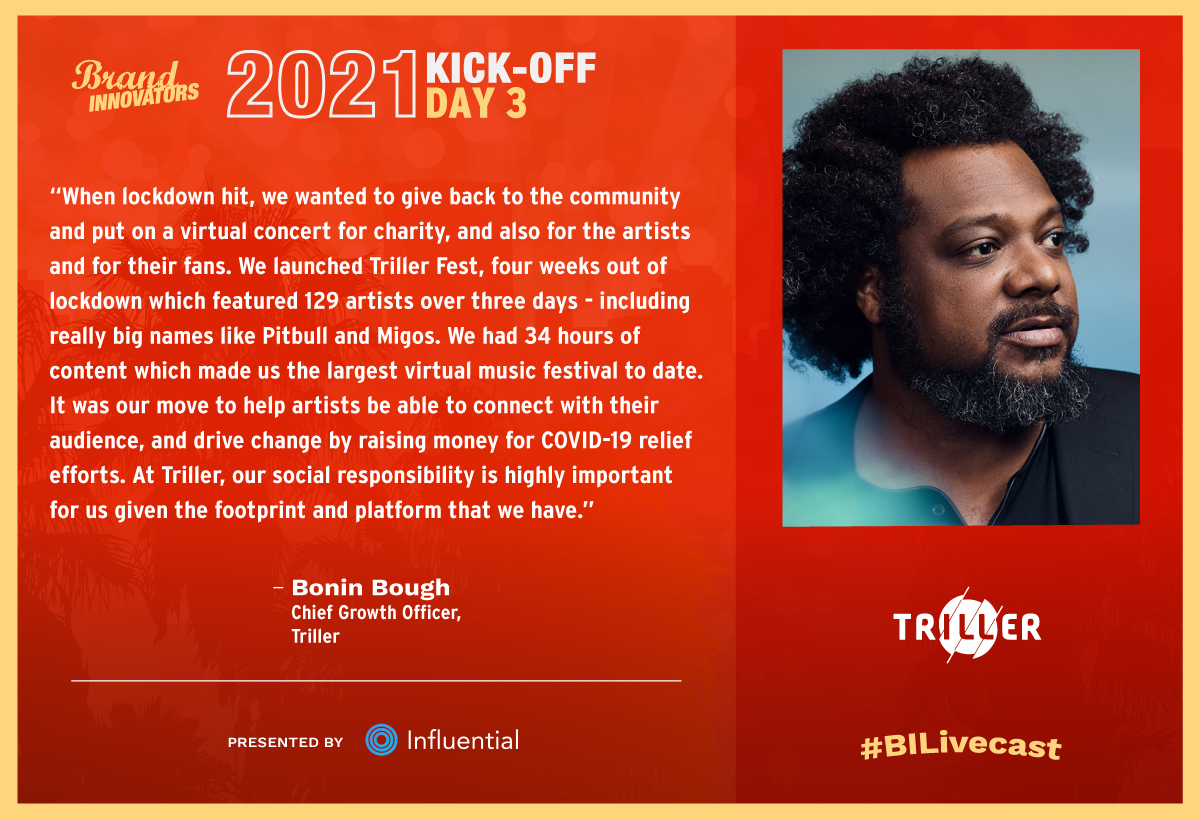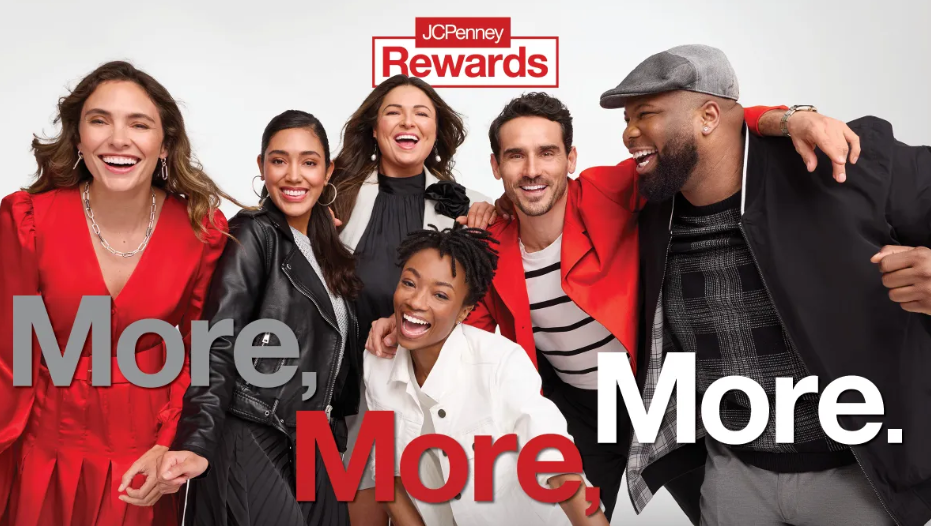The pandemic taught companies the importance of innovation and compassion, while brands that continue to adopt these principles are well-poised for 2021.
Thought leaders from brands including Triller, HBO, P&G, GSK, Mack Weldon, Activision Blizzard Esports, Lenovo, Qualcomm, and Fox Entertainment were among those that shared their stories of a transformative year and hope for a new one, during Day 3 of the Brand Innovators 2021 Kickoff event last week.
Creative platform Triller, “the influencer of influencers” where the likes of Lil Nas X got his start, is built on helping creative people monetize their projects and find audiences and partners to support their projects. When COVID hit, a harrowing time for performers, Triller built out a live product to help emerging artists find audiences and get paid for virtual concerts.
“When lockdown began, we wanted to give back to the community and put on a virtual concert for charity, and also for the artists and for their fans,” said Bonin Bough, Chief Growth Officer at Triller. “We launched Triller Fest, four weeks out of lockdown which featured 129 artists over three days – including really big names like Pitbull and Migos. We had 34 hours of content which made us the largest virtual music festival to date. It was our move to help artists be able to connect with their audience, and drive change by raising money for COVID-19 relief efforts. At Triller, our social responsibility is highly important for us given the footprint and platform that we have.”
Purpose was also key to P&G brand Gillette during the pandemic. Inspired by his own childhood aspirations to use “the best a man can get,” Pankaj Bhalla, SVP & GM, Grooming, P&G said that brands need to go beyond selling and connect to consumers’ connection to personal care, a soothing behavior that helped many people during the pandemic.
“That one ad gave us the confidence to reestablish our purpose of grooming which is to groom the next generation of men because they are watching,” said Bhalla. “Brands must stand for more than just their functional benefit. Each brand must use its voice to do good, as it does business and those two things don’t have to be mutually exclusive. It’s a business strategy that allows consumers to connect with brands more deeply.”
Pharmaceutical company GSK looks across the customer journey to see how they can be there when the consumer feels healthy, when the consumer starts to feel vulnerable, when the consumer feels sick, and when the consumer starts to go into recovery mode. Throughout this journey, they hope to offer support and innovate the customer experience.
“What is the innovation of the future? Will it be a potion or a pill? Or something that enhances the pill or something that potentially replaces the pill? Virtual reality is used in certain instances to treat patients, so you can put them through a VR immersive session, and it turns out it’s actually helping the consumer to go through the changing of the bandages in a way that is much easier than taking a pill,” said Marc Speichert, Global Chief Digital Officer, GSK. “In the future, we believe having the pill or potion will always be critical, but more and more there will be an expectation from consumers to have an experience that surrounds the pill or potion.”
Data plays a core role for HBO, but the challenge is making sure that they are focusing on the signals that matter. “You need to understand the common metrics which you are looking at to measure over time,” said Jim Marsh, SVP Program Marketing, HBO. “Data by itself has limited use; Data that can be analyzed in context and measured over time is very powerful. You’ll begin to see compelling patterns.”
Mack Weldon has adjusted to meet customers where they currently are and understand how to best serve people spending a majority of their time indoors.
The first step was determining how to talk to customers when there is a lot of fear and uncertainty in the country. They focused on featuring products indoors to make it clear that the brand could fit into pandemic life. As an ecommerce-driven brand, they were able to focus on customer experience and drive traffic to their own website.
“Mack Weldon is the place for customers who want amazing premium basics, love technical innovation and are looking for the best apparel that fits their lifestyle,” said Andy Rosenberg, Director, Brand Marketing, Mack Weldon. “By keeping our messaging simple and straightforward, it allows the product to speak for itself and people to see themselves in our brand. We want to deliver a great product story that really communicates the value of each product.”
Rosenberg was joined at the three-day summit by senior marketing executives at Activision Blizzard, Lenovo, Qualcomm, Ogilvy Consulting, and Fox Entertainment among many others. Here are five key takeaways for building strong brands in 2021. Head to Brand Innovators’ YouTube page to watch the whole event.
Focus on building engagement. Esports fans are so appealing to brands because of the deep engagement they have on the platforms. The ability to be a real participant facilitates this engagement.
“We’ve been able to foster that through the access that we’ve given them,” said Kristin Connelly, Sr. Director Marketing, Overwatch & Call of Duty, Activision Blizzard Esports. “How powerful is it that we allow our fans to control the product that we are creating? Because of that, they’re even more engaged and that’s just one of the many examples that fosters that deepened engagement. We purposely include the community and the fans as part of our decision making and as part of our product to really help us build it together.”
Be positive but realistic. Consumers have been through a tough year and want brands to offer a positive outlook but not one that is tone deaf. “Consumers are going to be looking for the brands that are painting a positive but realistic view of what’s to come, and how they authentically fit into that,” said Quinn O’Brien, Worldwide GVP, Global Brand and Marketing, Lenovo.
“Audiences are going to reject the brands that are overly optimistic for no reason, and also reject the brands that are churning away with their business,” she added. “It’s the brands that show up with empathy and transparency and are able to show realistic optimism. Once you anchor that mindset in something you’re actually providing, that’s the secret sauce to me.”
Imagine new possibilities. Try to imagine how new technologies can support new platforms and services, even if it hasn’t been invented yet. “When 4G launched, no one could conceive the idea of Uber, ride sharing wasn’t a thing,” said Don McGuire, SVP Marketing, Qualcomm. “The Uber concept was truly only enabled because of 4G. We’re waiting on the next Uber, those creative minds out there, to invent that next killer app that really leverages the capabilities of 5G.”
Adapt to the culture. Instead of trying to impose your brand onto the marketplace, consider the culture and figure out ways that your brand can help people out.
“Lay out your landscape in a way that makes sense for your brand and company and try to figure out how you really fit in it,” said Ashley Wood, Senior Global Consulting Partner, Ogilvy Consulting. “That’s really first and foremost what everyone really needs to do because the market is the Wild West – it’s emerging and morphing constantly. Every week there is something new being invented and introduced to the ecosystem which makes it quite exciting.”
Innovate in crisis. The pandemic uprooted the way that many companies do business. For many, this time period has been transformative and innovative.
“We’ve learned that a crisis can be an opportunity,” said Tulani Elisa, Vice President, Social Media, Fox Entertainment. “Our ‘TV For All’ campaign was originally supposed to launch during June 2020 for Pride Month, but we realized that that messaging really resonated with everything that was happening during the pandemic. We put so much importance on D&I and having conversations about the hard stuff. We want our content to be sensitive to what people are going through, but also evolving. It’s important that brands don’t just stick to whatever media plans they had before. There is not a normal to return to – we can only go forward and progress. We try to make sure we are a part of the conversation, not just watching it happen.”




